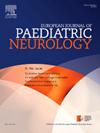Brain morphometry and psychomotor development in children with PCH2A
IF 2.3
3区 医学
Q3 CLINICAL NEUROLOGY
引用次数: 0
Abstract
Introduction
Pontocerebellar hypoplasia type 2A (PCH2A) is a rare neurogenetic disease characterized by severe cognitive and motor impairment. This study reports on brain morphometry and psychomotor development of affected children.
Materials and methods
We analyzed 78 cerebral MRI datasets of 57 patients with genetically confirmed PCH2A. Volumetric and in-plane measurements were conducted in cerebellum, neocortex and pons. Supratentorial width and width of the anterior horns of the lateral ventricles was used to calculate the Evans index. Caregivers of 65 patients (aged 7 months to 33 years) filled in a survey assessing motor and cognitive development. Developmental status was compared to MRI measurements.
Results
In children with PCH2A, cerebellar volume was markedly smaller than in healthy children at birth, with slower increase and stagnation at around 12 months. No cerebellar growth was observed in the cranio-caudal axis. Longitudinal data did not reveal a decrease in cerebellar volume or in-plane measurements. Supratentorial measurements showed progressive microcephaly and a continuous increase of the Evans index, reflecting progressive cerebral atrophy. Patients demonstrated severe cognitive and motor impairments, with developmental regression reported in only a minority. No statistical relationship between brain measurements and cognitive or motor development was observed.
Conclusion
MRI in PCH2A patients shows limited cerebellar growth during infancy, especially restricted along the cranio-caudal axis. After infancy, cerebellar volume remains relatively stable. Supratentorial measurements indicate slowly progressive atrophy. Psychomotor development is significantly impaired, but regression is rare.
PCH2A患儿脑形态测量学与精神运动发育
2A型桥小脑发育不全(PCH2A)是一种罕见的神经遗传性疾病,以严重的认知和运动障碍为特征。本研究报告了患病儿童的脑形态测量和精神运动发展。材料与方法我们分析了57例经遗传证实的PCH2A患者的78组脑MRI数据集。对小脑、新皮层和脑桥进行了体积和面内测量。采用侧脑室前角和幕上宽度计算Evans指数。65名患者(7个月至33岁)的护理人员填写了一份评估运动和认知发展的调查。发育状况与MRI测量结果进行比较。结果PCH2A患儿出生时小脑体积明显小于正常儿童,12月龄左右小脑体积增长缓慢,停滞不前。颅尾轴未见小脑生长。纵向数据没有显示小脑体积或平面测量的减少。幕上测量显示进行性小头畸形和Evans指数持续升高,反映进行性脑萎缩。患者表现出严重的认知和运动障碍,只有少数患者出现发育倒退。没有观察到大脑测量与认知或运动发育之间的统计关系。结论mri显示婴儿期PCH2A患者小脑发育受限,尤其是颅尾轴发育受限。婴儿期后,小脑容量保持相对稳定。幕上测量显示缓慢进行性萎缩。精神运动发育明显受损,但很少出现倒退。
本文章由计算机程序翻译,如有差异,请以英文原文为准。
求助全文
约1分钟内获得全文
求助全文
来源期刊
CiteScore
6.30
自引率
3.20%
发文量
115
审稿时长
81 days
期刊介绍:
The European Journal of Paediatric Neurology is the Official Journal of the European Paediatric Neurology Society, successor to the long-established European Federation of Child Neurology Societies.
Under the guidance of a prestigious International editorial board, this multi-disciplinary journal publishes exciting clinical and experimental research in this rapidly expanding field. High quality papers written by leading experts encompass all the major diseases including epilepsy, movement disorders, neuromuscular disorders, neurodegenerative disorders and intellectual disability.
Other exciting highlights include articles on brain imaging and neonatal neurology, and the publication of regularly updated tables relating to the main groups of disorders.

 求助内容:
求助内容: 应助结果提醒方式:
应助结果提醒方式:


